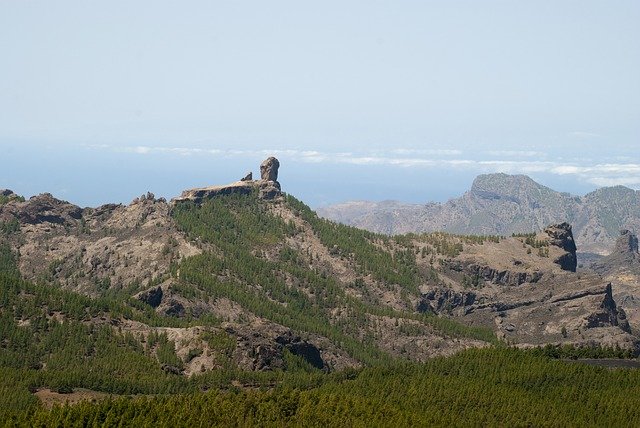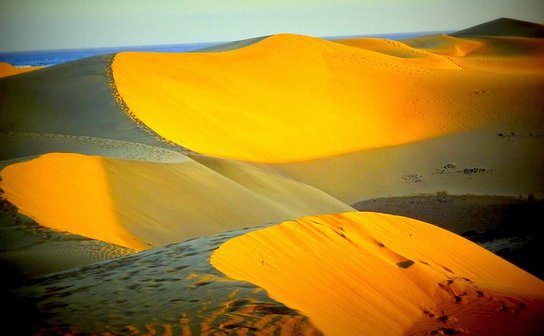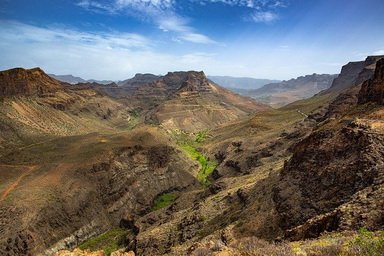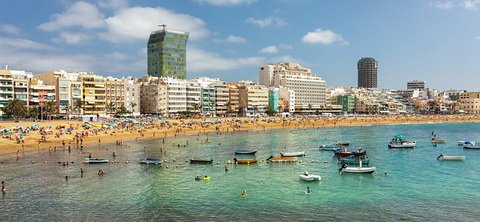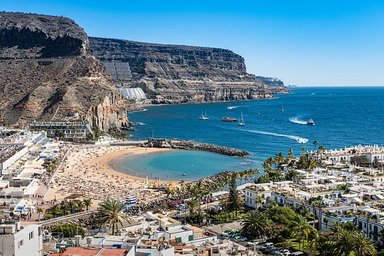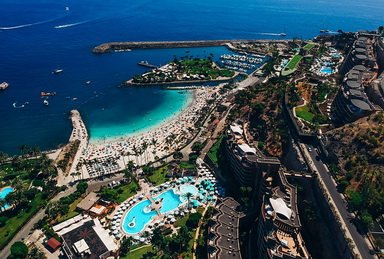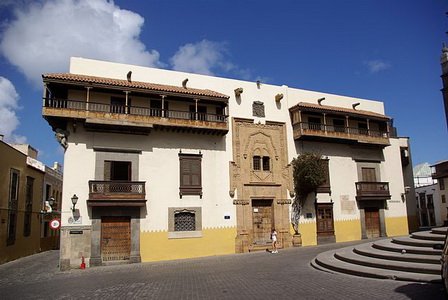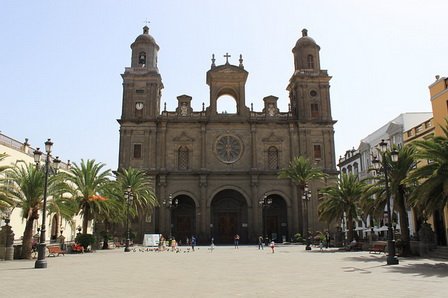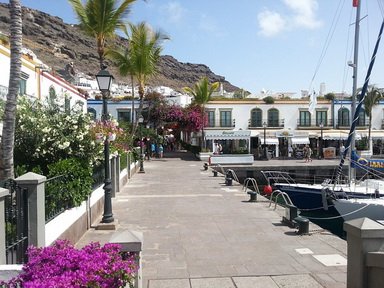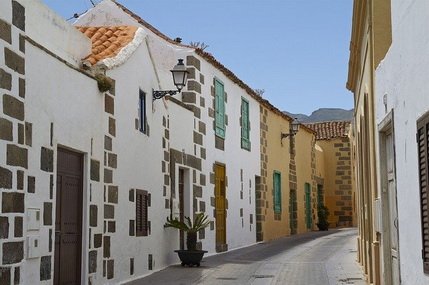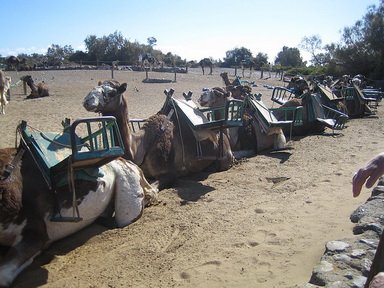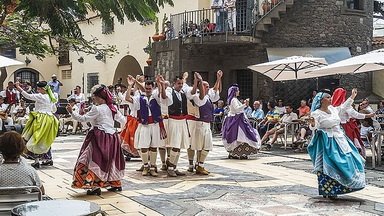Main attractions – Gran Canaria
View on the map
The Canary Islands treat themselves as one, but for obvious reasons they are divided. Because of this each of the islands has its own set of attractions. But when you look at them, you can group them into the same categories. We have nature’s wonders, which are by far the best attractions of the Canary Islands! Then you have Instagram beaches, lovely towns, museums, fun-places, and day tours.
Follow these few articles and choose the best option for you.
1 Roque Nublo
The most visited rock in Gran Canaria can be found in the heart of the island, in the municipality of Tejeda. Looking at the landscape it is difficult to imagine that there was a volcano there once. When the magma chamber emptied, everything collapsed creating a depression called a caldera. You can see it clearly by visiting Bandana Caldera – wonderfully round and stunning.
The region of Tejeda is on the other hand shaped beautifully – with winding roads and surprises after each turn. The ridge of the caldera forms spectacular shapes and one of those is Roque Nublo. It is best to get there by car, and walk the shortest distance of 1,5km (+/- 30 minutes one way). The path is not too difficult but be prepared. After half an hour you will arrive at the height of about 1800 meters (it is the second-highest point in Gran Canaria – the rock stands up to 1813 m).
Roque Nublo is a spectacular giant that can be seen from different parts of the region. It stands as a guardian at the edge of the earth and sky. It is easy to imagine why it was a place of the rituals. Try distinguishing the shapes of his companions that you meet on the way – the frog or the pilgrim. There are also more paths there if you are up for a day of hiking.
Standing there you will have Gran Canaria at your feet, and you will even see Mount Teide on Tenerife. At different times of the day and year, the landscape offers mist, clouds, perfect visibility to the end of the world, or spectacular sunsets. Choose the best time for you.
2 Maspalomas Dunes
The south of Gran Canaria is popular among tourists for many reasons. The sun, the holiday resorts, beaches, clear water…It all makes the perfect holidays. And all in the proximity of the island’s own mini desert!
The dunes of Maspalomas (a resort nearby) are a protected Natural Reserve today. They cover about 400ha, but the visitors can walk only on certain paths. The most recent COVID situation greatly improved the health of the dunes, which are unendingly shifting and moving. The sand wasn’t carried from Sahara as some people say. These are the tiny particles from the Atlantic sea, that have been carried by the wind. The shallow waters still form a wonderful lagoon, and the “desert” has its own “oasis”.
Close to the Dunes is the Maspalomas lighthouse. It was built in the XIX century when there was nothing yet in here. It witnessed the creation of a tourist place. It is also said to stand in the very spot where Christopher Columbus left for the Americas. You can spend a nice day making a 5 km trip between the lighthouse and Playa the Ingles, right among the dunes.
3 Bandama Caldera
Gran Canaria was formed by multiple eruptions and several volcanos. Therefore, it is more mountainous than the other islands. Time and erosion formed characteristic ridges, that create this beautiful landscape. Not every day you can rest at the beach, being able to almost touch the over 1000m high hills.
You can still see the remains of the volcanos and the most visited of those is the Bandama Caldera. It was shaped into a circular crater which has a depression of 200 metres. The bottom is filled with volcanic sands of different colours. They allowed various vegetation to grow there. At some points there were even vineyards in the area – they were profiting from the rich soil.
Try walking around it or go down to its deepest part if you have good shoes. You also cannot miss the Bandama viewpoint (570m high) which will give you the perfect photo, views of the neighboring cities and sometimes – Fuerteventura. The trail is not too long – about 3 kilometers with the viewpoint. It should take you about 2 hours. Be prepared for the weather conditions and avoid this path after heavy rains. You may want to link this spot with the visit to the botanical gardens – Jardin Botanico Viera y Clavijo.
Bandama Caldera is accessible by bus or by car. It is not far from the town of Montagneta in the NE part of the island. It is between Las Palmas and Santa Brigida.
3 Bandama Caldera
Gran Canaria was formed by multiple eruptions and several volcanos. Therefore, it is more mountainous than the other islands. Time and erosion formed characteristic ridges, that create this beautiful landscape. Not every day you can rest at the beach, being able to almost touch the over 1000m high hills.
You can still see the remains of the volcanos and the most visited of those is the Bandama Caldera. It was shaped into a circular crater which has a depression of 200 metres. The bottom is filled with volcanic sands of different colours. They allowed various vegetation to grow there. At some points there were even vineyards in the area – they were profiting from the rich soil.
Try walking around it or go down to its deepest part if you have good shoes. You also cannot miss the Bandama viewpoint (570m high) which will give you the perfect photo, views of the neighbouring cities and sometimes – Fuertaventura. The trail is not too long – about 3 kilometres with the viewpoint. It should take you about 2 hours. Be prepared for the weather conditions and avoid this path after heavy rains. You may want to link this spot with the visit to the botanical gardens – Jardin Botanico Viera y Clavijo.
Bandama Caldera is accessible by bus or with a car. It is not far from the town of Montagneta in the NE part of the island. It is between Las Palmas and Sainta Brigida.
3 Bandama Caldera
Gran Canaria was formed by multiple eruptions and several volcanos. Therefore, it is more mountainous than the other islands. Time and erosion formed characteristic ridges, that create this beautiful landscape. Not every day you can rest at the beach, being able to almost touch the over 1000m high hills.
You can still see the remains of the volcanos and the most visited of those is the Bandama Caldera. It was shaped into a circular crater which has a depression of 200 metres. The bottom is filled with volcanic sands of different colours. They allowed various vegetation to grow there. At some points there were even vineyards in the area – they were profiting from the rich soil.
Try walking around it or go down to its deepest part if you have good shoes. You also cannot miss the Bandama viewpoint (570m high) which will give you the perfect photo, views of the neighbouring cities and sometimes – Fuertaventura. The trail is not too long – about 3 kilometres with the viewpoint. It should take you about 2 hours. Be prepared for the weather conditions and avoid this path after heavy rains. You may want to link this spot with the visit to the botanical gardens – Jardin Botanico Viera y Clavijo.
Bandama Caldera is accessible by bus or with a car. It is not far from the town of Montagneta in the NE part of the island. It is between Las Palmas and Sainta Brigida.
4 More NATURE
It is difficult to describe all the natural wonders of these islands. You will surely enjoy traveling to its heart – whether on your own or on a safari tour. There are many places to try: Guayadeque Ravine (on the photo) or the highest peak – Pico de las Nieves (1949 m above sea level, 4a on the map). Try the lookouts like Degollada de la Vegua, Mirador del Molino (4d) or Mirador del Balcon. Or just stop at a place you like and name it for yourself!
Think about visiting the caves which are both in the northern parts of the island. You have a choice between an archaeological park with its Cuevas Pintadas (4b). This will remind you about the first inhabitants of the island. Or the “Monastery” of Valeron (4c) which is both a cave and a curious geological structure. It is known that people lived there, but once you see the wall with holes you first think of a beehive. Then you have questions ranging from mystical to historical. It is a complex system of caves and a spectacular sight.
5 Beaches
Gran Canaria offers over 80 beaches for the seekers of different thrills. If you are looking for golden sands, you will find them. The same goes for those wanting a rocky place, an off-road one, or some peace and quiet. You have resort beaches, next to the shopping areas and bustling nightlife. You can bathe in the azure sea, play with waves, do water sports, or sunbathe. Go to the south for more sand and fun. Northern parts are quieter, more pebbled, but equally captivating.
Some of the major spots you will find throughout the Internet are:
- Playa Las Canteras (Las Palmas, on the photo above)
… a long strip of sand both close to the shopping area and far from it. A bit of everything for everyone – sunbathing, snorkeling, waves, just name it
- Amadores Beach (close to Puerto Rico de GC)
…romantic views, protected atoll with calm waters and golden-white sand. It is close to Puerto Rico and its livelier beach. But if you prefer to be a bit further from the city – here it is
- Playa de Ingles
…the beach close to the famous dunes is a great spot for those looking for a lively place. It is close to a town, there is a shopping centre nearby and it offers a multitude of fun activities
- San Augustin
…come here looking for a smaller town, and less known place. This piece of a shore is covered with darkened by volcanic ash sand and it doesn’t look like a perfect beach. This is what the people coming here looking for! It is both calm and close to the restaurants. You can relax there, bathe in calm waters or enjoy some snorkelling
- Playa de las Nieves
…situated in the city of the same name is pebbled and well protected from the harshness of the sea. You get the views of great cliffs right next to it and you will be surprised by the gentle waves. The city was a fishing village, and you cannot miss some fish or seafood there
- Guayedra
…is the northern beach known mostly to the locals. It is quite difficult to get to, but because of it you can have it all to yourself. Especially during the weekdays. It is a mixture of pebbles and sand protected by the cliffs
- Playa da Aquadulce (East coast)
…another remote spot, tiny and sometimes windy. But on a calm day you can get the turquoise waters and sand all to yourself.
Big or small – the beaches of Gran Canaria have a lot to offer. Follow the locals to find hidden places, not described in the Internet. Or go for a ride from one sea resort to the next and find the most popular places like the beach of Puerto de Mogan or Anfi del Mar (both on photos above. The choice is yours.
6 Las Palmas
Coming to the capital of Gran Canaria you cannot really see the invaders that founded it in the XV century. But you can learn a lot about it by visiting some of the museums. The old city of Vegueta has the Museo Canario, which will tell you the story of the first inhabitants of the island. You will love the old architecture of this district. It is a mixture of white and sandy houses with stone elements. Green plants and trees surround it.
Visit Casa the Colon on your way through it – it will tell you how Christopher Columbus found his way to the Canary Islands. It was once a governor’s home and you can see some of its grandeur when you look at it.
This old “pueblo-like” place is a house to lovely Santa Ana Cathedral. It stands on a square of the same name since the beginnings of the city. It is a mixture of different architectural styles, which make her even more eye-catching.
Check out the narrow passage leading to La Isleta. The neighborhood is more contemporary here and the area is loved by the locals. They like to spend their time here, rest, walk, look at the passers-by. And it is right between the two beaches – La Canteras and Alcaraveneras, so if you are bored with one, you can hop to the other or go shopping. You will find here a port, lovely parks, a few museums, art, Castillo de la Luz (old fortifications) and the famous Mercado del Puerto.
Do not forget about la Isleta itself. A mixture of colorful houses of various shapes is mesmerizing. They say it is because they were built slowly by the inhabitants. It is a true labyrinth, and a part of the famous Carnival happens here. As if you would need even more reasons to come here.
7 Other TOWNS
Puerto de Mogan is one of the most beautiful towns in the south of Gran Canaria. It grew out of a fishing village. These traditions are continued, and the city is sometimes called the little Venice. You will find great food there, a popular Friday market and a beach. You will love the typical buildings painted into white colors and their romantic spots, squares, and gardens.
The cathedral of San Juan de Bautista seems out of place in the small, calm town of Arucas (7a). But this northern city has much more to offer. The church was built at the beginning of the century and is a jewel made by local artisans and people. The square San Juan is equally famous. You will find traditional buildings ranging from the 17th to the 20th century there. The whole area is of historic and artistic importance. Locals still love to gather there, and you will love the atmosphere of the place. And if it is not enough – visit the local rum distillery.
Artenara will give you the views of the “petrified storms” described by the writer Unamuno (check out the viewpoint – Mirador de Unamuno). It is quite close to Roque Nublo, and just because of it – very convenient to visit.
Aguimes is a south-eastern town that grew around a cathedral, witnessed many people depart to the Americas, and became an important place of trade of the sugar cane, tomatoes, and cucumbers. You will be charmed by the traditional architecture of the limestone buildings. Firgas (7b) has the iconic now – Paseo de Canarias – a flight of stairs and mini-waterfalls that are a perfect spot for a photo. They are also quite informative – presenting local crests and maps.
Fataga (7c) is tiny but known thanks to a camel ride to the Valley of 1000 Palms (photo of the camels below). Teror (7d) sounds scary but you will love that it was stopped in time. Wandering the streets there is like walking in the footsteps of the first Spaniards that came to Gran Canaria. Maybe the Lady of a Pine will grant you a miracle if you pray hard. If not – try the local chorizo or search for some handcrafted items in the market.
Many towns of Gran Canaria have their inner charm and it will be difficult to part from there. You have a coastal town bustling with life and tourists. You also have mountain towns, hidden in the valleys and between the hills, guarding their secrets and individuality. Take your time exploring and knowing as many of them as you want.
8 Having FUN
Apart from the nightlife and beach activities, the island offers some interesting fun parks.
Pueblo Canario can be the most attractive for those wanting to dive into the local culture. You will find it in Las Palmas, close to the Doramas Park (in google, search for the restaurant Bodegón del Pueblo Canario). A few times a week there are presentations of local crafts. Traditional dances (photo below) show in Canarian clothes is one of the most popular (on Saturday mornings). It is all accompanied by folkloric music, great local food, and shops offering not only souvenirs.
Sioux Park (number 8 on the map) seems out of place but is great fun for kids. Atmosphere taken out of a western is captivating and the horses making tricks – wonderful. Try it if you will be looking for some activities in the south. Or take the little ones to the Aquarium Poema del Mar in Las Palmas (the wall of fish is amazing!) or Palmitas Park in the South (Zoo Park with a great dolphin show).
You should also love the submarine experience. Puerto de Mogan offers you a ride in a yellow vehicle that takes you to a submerged Atlantida. If only it was true… but the artificial reef is a wonder and is quickly turning into its own underwater ecosystem.
Last, but not least – the carnival season (remember that it exists on Gran Canaria – check the dates) and the Moonlight Cinema of Maspalomas. If you have ever wanted to see a movie under the night sky not feeling the cold – this is a place to go. The seats are comfortable, you have a blanket that you will probably not need, and feel more at home than in a cinema.
Enjoy Gran Canaria!

